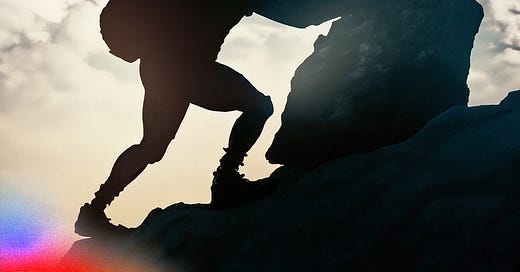We’ve probably all heard of Sisyphus, condemned to eternally pushing a boulder up a hill, only for it to roll back down again. But Albert Camus, the French philosopher and writer, found an interesting perspective in this story. He asks us to imagine Sisyphus happy, even in his eternal struggle. That sounds easy when things are going well. But on days of deep grief, or stressful chaos, we need a framework to guide our thoughts and actions.
Enter the OODA Loop - a decision making framework developed by military strategist John Boyd. Originally the cyclic process of Observation, Orientation, Decision, and Action was developed for competitive scenarios. But in our current reality, everything competes for our attention. In this new reality, we are constantly swamped with information, leading to an over-stimulated brain. The aim is to develop a path to observation and orientation that allows us to leave the world in a better place than we found it, one situation at a time.
In “The Science of Storytelling,” Will Storr says “who we are is how we’re broken.” To develop a mindset of awareness, we need to understand how past experiences have distorted our perceptions and reactions. The things that happen to us warp and twist what we see, which in turn affects how we react. It's a deep dive into our psyche, but essential if we want to change our worldviews.
It is here where we can start to unlearn, which is a critical part of learning. Shane Parrish, founder of Farnam Street (fs.blog) said “how quickly you unlearn what you think you know often determines how far you go.” Shedding the rigidity of preconceived notions makes space for new perspectives.
All of this hard work, of digging deep, and pruning our minds, requires a mental space where we can observe and orient ourselves. Meditation is an effective tool for developing this space, and for learning how to return to it naturally. Ultimately it is our goal to move away from being reactive, and towards being proactive.
While in a concentration camp, experiencing untold horrors, Viktor Frankl wrote: “Between stimulus and response, there is a space. In that space is our power to choose our response. In our response lies our growth and our freedom.” This is the space we strive to find, the pause between the peaks and valleys of our Sisyphean tasks.
In the words of Albert Camus, “The struggle itself towards the heights is enough to fill a man’s heart. One must imagine Sisyphus happy.” We imagine ourselves content in our journey, striving for joy and peace in the spaces we carve out. Eventually we learn that our struggles are not futile Sisyphean tasks, but steps in a journey, offering us opportunities to learn, and grow.
I’m experiencing grief and loss today, and so I write this with just a little spark of hope. In this spark, however small, I’m striving to find the space I need to do the work of learning, or unlearning, and growing. I know my practice is leading to a more peaceful and more proactive life. The hard times feel like they stretch into infinity sometimes. And my heart is certainly filled with the struggle to the heights. I suppose now I must strive to imagine myself happy, or at least content, with what I have.





